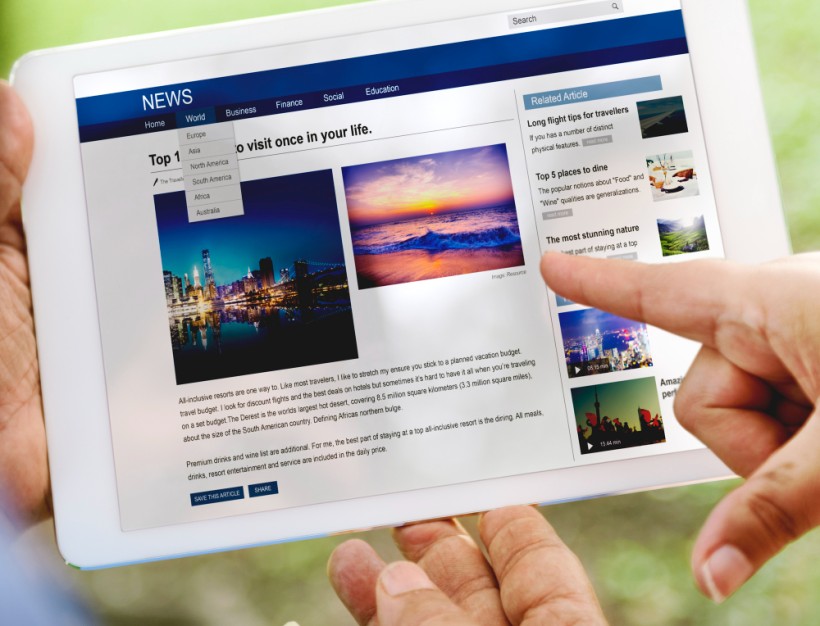You land a headline, celebrate, then watch your traffic drop two days later. That’s the illusion of coverage—thinking one big story equals success.
Attention fades fast, and your audience might not even read that outlet. News moves too quickly, journalists are stretched thin, and competition for space is steep.
Meanwhile, audiences spend more time in podcasts, newsletters, and communities where trust builds slowly. Limiting your PR to news means losing control and missing depth.
A mix of owned, earned, and community channels lets you track results, spread risk, and reach people in more meaningful ways.
We’ve divided the following tactics and channels into six sections:
- Owned media channels
- Earned and shared media channels
- Paid amplification
- Community and relationship channels
- Search and discoverability
- Direct engagement
Section A: Owned media
Owned channels are the foundation of your communications strategy. They’re where you control the message, timing, and format.
- Company website: Your newsroom, blog, or resources page tells your story on your terms. Measure engagement through traffic, time on page, and backlinks. You’ll need a CMS (like WordPress or Wix), Google Analytics, and consistent content.
- Email newsletters: A direct line to your audience. Newsletters (including LinkedIn Newsletters) are great for building loyalty and repeat engagement. Track open and click-through rates, and start with a clear signup flow and simple segmentation.
- Podcasts: Perfect for storytelling and thought leadership, podcasts are a great addition to your PR strategy. Measure downloads, completion rate, and listener retention. You’ll need recording equipment, editing software, and a content plan.
- Webinars and livestreams: These combine authority and interactivity. Track registrations, live attendance, and questions asked, and follow up after the webinar. Use Google Meet, Zoom, or LinkedIn Live for webinar planning.
- White papers, reports, and case studies: We’re strong advocates of original research. Reports and white papers show proof of expertise and are easily repurposed across channels. Track downloads, citations, and impact on sales conversations. Start with one flagship piece per quarter. Get more info on white paper pricing.
- Social media profiles: Extend your brand voice and engagement across the channels that matter to your business. Monitor reach, engagement, and sentiment, and try to keep a consistent content calendar. Learn more in our piece on social media strategy.
- CEO or founder posts: Should you focus on your company page vs. your founder’s profile? We’ve found the latter to be more effective, but it’s a trick question. Personal credibility amplifies corporate reputation. With this tactic, measure engagement quality over volume, and draft authentic posts with a clear point of view. AI can help somewhat, but don’t overdo it. Here’s our list of LinkedIn post ideas for founders.
- Internal communications: A strong culture and alignment is also good PR. Use engagement surveys and track participation rates (and word of mouth). Platforms like Slack or Teams help maintain visibility.
Section B: Earned and shared media
These channels build credibility by getting others to tell your story. They’re slower to earn but carry more weight when done right.
- Industry blogs and niche publications: Reach is nice, but you can also target smaller audiences that care deeply about your space (often cheaper, too). Track referral traffic, backlinks, and mentions. You’ll need solid insights, not just press releases.
- Influencer or expert collaborations: Partner with credible voices to extend reach, especially in B2B where this tactic is still under-used. Measure engagement, conversions, or co-created content views. Identify voices your audience already trusts, and aim for long-term influencer marketing collaborations.
- Guest posts or op-eds: Share your perspective on partner sites to grow authority, and track publication reach and shares. You’ll need to pitch useful ideas, not self-promotion; see our guide on how to write an op-ed.
- Community forums: Engage authentically in Slack, Reddit, Quora, or Discord groups. Measure comment karma, mentions, or thread engagement, and if able, use UTM codes in your hyperlinks to track traffic sources. Avoid over-promotion, or you might piss off the mods and admins. See a list of public Slack groups on Slofile.
- Awards and rankings: Most industry awards are pay-to-play, but you can boost short-term legitimacy through ‘official’ recognition. Track search traffic and press mentions after listing, though you can and should leverage award wins to more commercial goals, like winning pitches and proposals. Focus on credible, relevant awards, and avoid the fly-by-night ones.
- Podcasts hosted by others: Appear as a guest to tap into established audiences. Track referral traffic and listens, and take comfort knowing that most podcasts stay up forever (theoretically infinite reach). Prepare strong stories and examples, and bring good chat.
- Speaking slots: Position yourself as an authority at events or webinars. Track attendee numbers and post-event leads, and promote each keynote afterward (see our list of LinkedIn post ideas for speakers). Try to build slide decks that teach and entertain, not just sell.
- Partner newsletters: Reach aligned audiences through trusted partners, and aim to measure open rates, clickthrough rates, sales impact, and other related metrics. It helps to offer real value to their readers—thinking of it like bringing snacks and wine to someone else’s party.
- Wikipedia and reference entries: You can strengthen online authority and discoverability with your own Wikipedia entry. You’ll need to provide verified citations and use a neutral tone, and maintain it over time. You can track pageviews using Wikipedia’s PageView Analytics Tool.
Section C: Paid amplification
Paid channels help you scale what’s already working. They don’t replace organic efforts, but amplify them.
- Sponsored articles or native ads: Blend into editorial environments while promoting your story. Relevance is key here. Start with a clear message and strong visuals, and measure impressions, click-through rates, and referral traffic.
- Paid influencer placements: This is similar to the earned media version, except you’ll pay in cash or kind (e.g., complementary services, free subscriptions, gift cards). Various agencies and platforms can help you find and partner with creators who already reach your target audience. Choose partners whose tone and followers align with your brand, and track engagement, reach, and conversions.
- Sponsored podcast segments: Gain trust through voice-based storytelling. You’ll need a compelling talking point and a relevant host audience—try not to be boring. Measure downloads, mentions, and referral codes where applicable.
- Paid newsletter placements: Appear in niche newsletters your audience already reads. Research newsletters with high engagement and transparent pricing, and track clicks and sign-ups.
- Paid social media boosts: Extend the life of organic posts with paid ads. Start with small tests across LinkedIn, Meta, or X to learn what performs. Follow best practices, and measure reach, clicks, and conversions.
- Event sponsorships or co-branding: Increase visibility and association with trusted brands. Align sponsorships with your message and target community, and consider repurposing the collaboration’s output. Track booth traffic, leads, and mentions. See how we turned a LinkedIn Local event into a media-ready report.
Section D: Community and relationship channels
These channels strengthen trust, credibility, and long-term relationships across networks that shape perception and advocacy.
- Industry associations or chambers of commerce: Build legitimacy and access to industry conversations by joining these and staying active. Measure event participation, mentions, and referrals. My friend Claire Mason does a great job of this. (Incidentally, there’s another Claire Mason that does the same. Coincidence?)
- Academic collaborations: Partner with researchers or research agencies to co-create credible content. Measure citations, co-published reports, or media mentions. Start by identifying thought leaders in your field you can do this with and designing media-ready surveys. Read our PR case study for an example of how this plays out in the media.
- NGO and advocacy networks: Align with social causes to build goodwill and relevance. For example, a fashion brand can align with an NGO that distributes winter clothing to the less fortunate, while a pharma leader can collaborate with a healthcare non-profit. Engage where values overlap, and measure partnership visibility and outcomes.
- Local community outreach and CSR initiatives: Similar to the NGO tactic, except you’re doing it yourself. Track local press coverage and participation at your events or initiatives, and focus on meaningful, consistent engagement (ideally annually).
- Alumni and professional networks: Participate in alumni events to leverage existing trust for visibility. Generate and track speaking invites or referrals.
- Employee advocacy programs: Done well, you can turn your team into brand storytellers. Provide simple tools and incentives, like templates, suggested captions, or internal leaderboards to encourage participation. Measure post reach and engagement from employee shares, but make it voluntary, not mandatory.
Section E: Search and discoverability
Search visibility turns short-term wins into lasting reach. These channels make sure your stories can actually be found long after you share them.
- SEO-optimized articles and press releases: Use targeted keywords and structured formatting to rank in search. Measure impressions, clicks, and backlinks. You’ll need basic keyword research, a content calendar, and possibly a press release tool. SEO is worth the investment.
- Google News and content aggregators: Submit your site or newsroom for indexing to reach wider audiences. Track impressions and referral traffic, and keep an eye on the Discover tab in Google Search Console. Maintain consistent updates and technical SEO compliance.
- LinkedIn articles and Medium posts: Repurpose insights for discoverable long-form content. Measure reads, engagement, and follower growth to your company page or personal profile. Start with one platform and share consistently.
- YouTube and video SEO: Optimize titles, descriptions, and thumbnails to boost watch time. Use keyword tools and consistent publishing cadence., and track views, retention rate, and subscriber growth. Your script matters, so put some thought into it—or hire a YouTube scriptwriting service.
Section F: Direct engagement
These channels help you connect directly with your audience, investors, and partners—closing the loop between awareness and trust.
- Investor relations communications: If you’re a public company, you’ll need to build transparency and confidence with stakeholders. Measure newsletter opens, investor queries, meeting participation, and of course—your stock price.
- Customer updates and changelogs: Keeping users informed about product changes or improvements is an untapped marketing channel. Track open rates, feedback, and feature adoption—but also upsells and churn rates. Use email automation tools or in-app notifications to spread the word.
- Event booths and trade shows: Create real-world touchpoints that drive awareness and lead generation. Measure foot traffic, sign-ups, and follow-up conversions. Plan with clear collateral and post-event workflows. See our guide to B2B event marketing.
- Analyst or partner briefings: Strengthen credibility and industry alignment with regular analyst engagements. Measure coverage, quotes, or endorsements. Prepare detailed decks and data-backed insights. Read a white paper on analyst relations we produced recently for a client in digital health.
- Private communities (Slack, Discord, or member forums): You can build ongoing dialogue with customers or advocates by starting your own community. Measure active members, retention, and overall sentiment (polls/surveys may help here). Moderate consistently and share valuable updates—you’ll be carrying the community quite a bit in the early days.
How to integrate multiple channels into one coherent PR strategy
You don’t need to use all 38 channels or tactics. The goal is to pick the few that align with your story, audience, and capacity—and weave them into one system. Integration turns scattered efforts into a coherent brand presence.
1. Start with the story, not the platform
Every great PR plan starts with clarity. What do you stand for? Why should anyone care? Before thinking about which channels to use, define your brand story—the human reason behind what you do. Here’s how founders and marketers should think about brand storytelling.
Once that’s clear, it becomes easy to decide where that story fits best for each event or piece of news. A values-driven brand can thrive on podcasts and thought leadership, while a product-led company might focus more on webinars, case studies, and demo content.
2. Segment your audiences
Different groups care about different things. Investors want clarity and traction. Journalists want proof and perspective. Customers want simplicity and trust.
Start by listing all your key stakeholders—customers, investors, media, partners, and employees. Then, match each group to the channels that speak to them best. A single announcement might need five tailored versions to truly land.
3. Balance credibility, reach, and control
Think of your channels as levers. News media gives credibility. Social and community spaces expand reach. Owned media gives control.
The trick is to balance these three forces. For example, use news media to validate your message, social channels to amplify it, and owned platforms to sustain it. This turns moments into momentum.
4. Repurpose content intelligently
You don’t need new ideas every week—you need smart reuse. Turn a single research report into a blog summary, a LinkedIn post, a podcast episode, a webinar, and a media pitch.
The goal is to extract full value from each piece of content while adapting tone and format for each audience. Content repurposing saves time, reinforces your narrative, and builds consistency.
5. Measure what matters
Good PR is measurable. Track awareness through mentions and backlinks, engagement through traffic and shares, and trust through sentiment and conversions—in addition to 100 other PR metrics.
The data helps you learn which channels move the needle and which drain resources. Treat PR like an ongoing system rather than a one-off announcement. Measure, refine, repeat.
Final thoughts on PR channels and tactics
News outlets will always have value, but they’re only one part of your corporate communications strategy. The real power lies in combining credibility from the media, engagement from communities, and control through owned channels.
When you treat PR as an ecosystem instead of a series of one-offs, every channel starts to work harder for you.
We help teams design and run multi-channel PR strategies that get you seen. Learn more today.
Mo is the founder and CEO of Column, helping leaders shape public opinion through content and research. Connect with him on LinkedIn.





